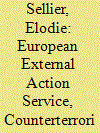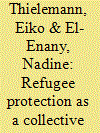|
|
|
Sort Order |
|
|
|
Items / Page
|
|
|
|
|
|
|
| Srl | Item |
| 1 |
ID:
163648


|
|
|
|
|
| Summary/Abstract |
The European External Action Service (EEAS), specifically mandated with enhancing coherence between the Common Foreign and Security Policy (CFSP) and non-CFSP bodies on the one hand, and the European Union and member states on the other hand, has the potential to increase CFSP’s contribution to the fight against terrorism and diminish the boundaries between CFSP and other policies. Several of the EEAS’ cooperation and coordination duties, as well as the inclusive composition of the Service, allow for a more coherent approach to counterterrorism policymaking. In practice, coherence is unfolding in diplomatic cooperation with third countries and Common Security and Defence Policy (CSDP) missions, as CFSP and Justice and Home Affairs actors seem to build on one another’s strengths. The picture is more nuanced in the area of intelligence, where the activities of the EU intelligence centre, transferred from the Council of the European Union to the EEAS, are conditional upon member states’ willingness to exchange information. Ultimately, current efforts towards coherence remain subject to a somewhat paradoxical two-speed process: one that encourages the meshing together of institutional actors and policy cultures, while deferring access to justice to national law, thereby yielding a system of protection of individuals à géométrie variable.
|
|
|
|
|
|
|
|
|
|
|
|
|
|
|
|
| 2 |
ID:
138869


|
|
|
|
|
| Summary/Abstract |
The growth of European Union (EU) competences in the field of external security in the last decade has produced a substantial increase in the number of EU institutions and bureaucratic actors engaged in the planning and management of these policies. Moreover, the expansion of competences in such a sovereign sensitive area comes up against the persistent tergovernmental nature of the security sector. This has resulted, on the one hand, in a complex institutional architecture with heavy demands in terms of coordination, and on the other hand, in a stark differentiation and stratification of the legal regimes with a potential to impact on policy outcomes. This state of uncertainty is particularly relevant when looking at relations with countries bordering the Union, as the long-standing web of interactions there has developed a more complex institutional environment. While most of the scholarly literature focuses on single institutional sectors or policies (Common Security and Defence Policy, European Neighbourhood Policy, or the external side of the Area of Freedom, Security and Justice), this study seeks to address the issue with a comprehensive analysis of the institutional framework that has emerged in the last decade, more notably, since the entry into force of the Treaty of Lisbon. The article provides, first, an overview of the EU’s institutional actors responsible for security policies in the regions bordering the EU, and second, an examination of the different mechanisms established to address the coordination issue. Finally, this study will argue that the traditional military dimension is but one, and certainly not the most developed, of the security instruments employed by the EU. At another level, it will be argued that the shift of focus from the military to other security tools has altered the institutional balance in the security sector, substantially adding to the relative influential weight of the Commission.
|
|
|
|
|
|
|
|
|
|
|
|
|
|
|
|
| 3 |
ID:
101140


|
|
|
|
|
| Publication |
2010.
|
| Summary/Abstract |
Refugee protection efforts have been shown to suffer from substantial collective action problems due to the capacity of restrictive policy measures adopted by one region as a means of shifting refugee responsibilities to other regions. Such responsibility-shifting dynamics have been identified between north and south as well as within these regions. European Union (EU) cooperation on asylum and refugee policies has been criticised for facilitating the adoption of restrictive policy measures and the creation of a 'Fortress Europe'. Fears about the hollowing out of refugee standards have been coupled with concerns about the EU's free-riding on the refugee protection efforts of countries outside the EU. This paper shows that overcoming collective action problems between the Member States has indeed been a key motivation for EU cooperation in this area. However, a comparative analysis of EU asylum laws and refugee protection efforts with those of similar developed countries outside the EU leads to the rejection of some of the assumptions and implications of the 'Fortress Europe' thesis. While there is evidence of north/south burden-shirking and substantial room for improvement in the EU's asylum and refugee regimes, comparative legal research and the analysis of available UNHCR data on other OECD countries suggests that there is no evidence to support the claim that European cooperation has led to uniquely restrictive refugee policies and protection outcomes.
|
|
|
|
|
|
|
|
|
|
|
|
|
|
|
|
| 4 |
ID:
091884


|
|
|
|
|
| Publication |
2009.
|
| Summary/Abstract |
In this article, we argue that the premature abolishment of the allegedly anachronistic concepts of internal versus external security is of doubtful heuristic value for the study of security practices. The two domains may gradually converge from the perspective of problems, but do so much less in terms of political practices. We show that security policy is pursued according to different systems of rules. It follows distinct institutional logics. We undertake a systematic comparison of policy-making in the European Union's Security and Defence Policy (ESDP) and Justice and Home Affairs (JHA). It is structured along the distinction between making and implementing an agreement as indicative stages of the policy-making process. First, rule-setting asks how decisions are made in the two domains: with or without the inclusion of external actors. Second, we explore whether the implementation of political decisions involves management or enforcement mechanisms. The empirical results are unambiguous: the political actors follow different systems of rules in the two domains. There are still 'ideal-typical' differences in a Weberian sense. This implies that internal and external security may be closely linked, like the opposite sides of the same coin, but must be separated for the purpose of analytical clarity.
|
|
|
|
|
|
|
|
|
|
|
|
|
|
|
|
|
|
|
|
|